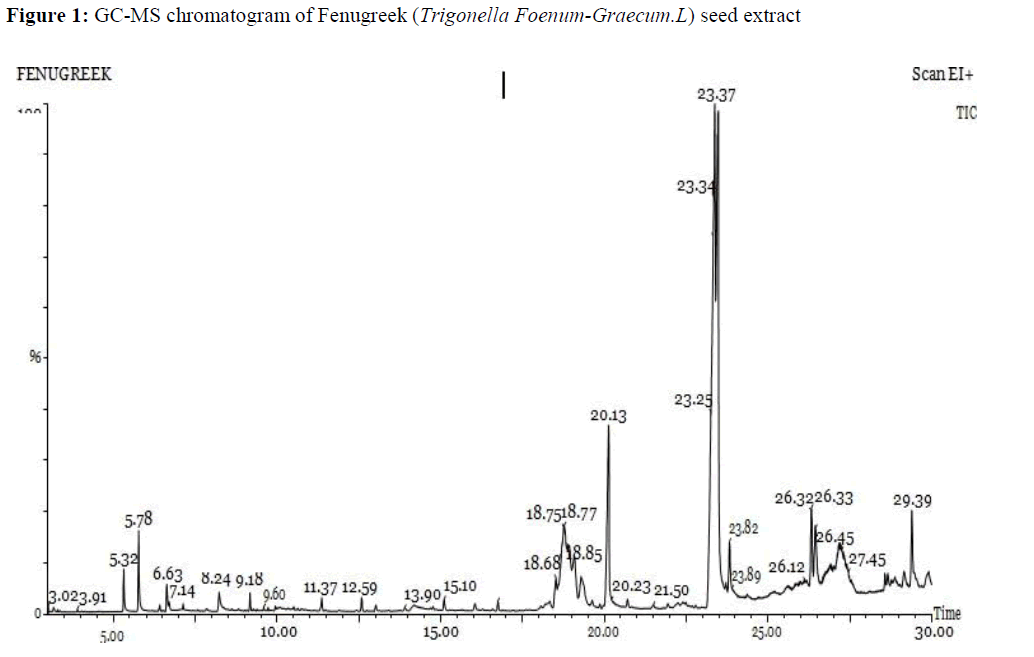ISSN : 2249 - 7412
Asian Journal of Plant Science & Research
Phyto-chemical Screening Analysis and Isolation of Bioactive Components in Fenugreek using GC-MS Study
M.Chenganmal*1 and C.Narayanan2
1Department of Textile Technology, K.S.Rangasamy College of Technology, Tirchengode, India
2Department of Science and Humanities, Gnanamani College Technology, Namakkal, India
- *Corresponding Author:
- M.Chenganmal
Department of Textile Technology,
KS Rangasamy College of Technology, Tirchengode,
India,
E-mail: chenganmal_62@rediffmail.com
Received date: August 19, 2019, Manuscript No. AJPSKY-22-1718; Editor Assigned date: June 17, 2022, PreQC No. AJPSKY-22-1718(PQ); Reviewed date: June 28, 2022, QC No. AJPSKY-22-1718; Revised date: July 08, 2022, Manuscript No. AJPSKY-22-1718(R); Published date: July 15, 2022, DOI: 10.36648/2249- 7412.12.7.301
Citation: Chenganmal M and Narayanan C (2022) Phyto-chemical Screening Analysis and Isolation of Bioactive Components in Fenugreek using GC-MS Study. Asian J Plant Sci Res Vol:12 No:7.
Abstract
The present study has focused on Fenugreek (Trigonella foenum-graecum.L) having antibiotic properties of antipyretic, anthelmintic, antileprotic, antibronchitic, carminative and anti-diabetic properties. The botanical name of the fenugreek is Trigonella foenum-graecum.L. The main aim of this study is to carry out phyto-chemical screening tests in the extract of Trigonella foenum-graecum.L to evaluate alkaloids, tannins, sterols, saponins, flavanoids, carbohydrates, glycosides, new anti-diabetic compound and various poly-phenol compound from plants available in our locality. As such, an attempt has been made to isolate the anti-diabetic compounds from the seed of Trigonella foenum-graecum.L. In this study, the solvent extraction study followed by using GC-MS Clarus SQ 8C Perkin Elmer to purify the compounds. Then, fenugreek seed powder extract analysis was conducted that revealed the presence of twenty one peaks of GC-MS chromatogram. Six chemical constituents were identified by GC-MS analysis. The major constituents were 4-t-Butyl-2-[4-nitrophenyl] phenol, n-Hexadecanoic acid, 9,12-Octadecadienoic acid (Z,Z), 9- Octadecadienoic acid (E), Octadecadienoic acid and Hexadecanoic acid, 2-hydroxy-1 which possess many antioxidant and biological activities. It can be applied in other food industries as a natural antioxidant instead of synthetic antioxidants that can be utilized for the growth of conventional medicines and further research needs to evaluate novel active compounds from the medicinal plants which may be produced in an enhanced way to treat many incurable diseases related to diabetes.
Keywords
Antipyretic; Trigonella foenum-graecum.L; Isolation; GC-MS; Anti-diabetic; Antioxidant; Immemorial; Fenugreek
Introduction
Herbs are used for diabetes treatment from the time immemorial. The plant extracts are used to combat diabetes. Many traditional medicines in use are derived from medicinal plants, minerals and organic matter. The World Health Organization (WHO) has listed 21,000 plants, which are used for medicinal purposes around the world. Among these, one hundred and fifty spices are used commercially on a fairly large scale. India is the largest producer of medicinal herbs and is called as botanical garden of the world. The current review focuses on herbs used in the treatment of diabetes mellitus, a major crippling disease in the world leading to huge economic losses. At last the World Health Organization (WHO) expert committee on diabetes has recommended that traditional medicinal herbs be further investigated. Covered here are medicinal herbs in India that have been confirmed by scientific investigation, which appear to be most effective, relatively non–toxic and have substantial documentation of efficiency. Shila Kant Lal Karna studied the phytochemical screening of the methanolic seed extract of Trigonella foenum–graecum and reveals the presence of flavonglycosides, carotenoids, polyphenols, alkaloid, fatty acids, essential oil [1]. Vijayalakshmi K et al. studied and concluded that Trigonella foenum graceum contains many important phytochemical like Aziridine, 1, 2,3-trimethyl-, trans-, which may prove to be a potent antimicrobial agent and isolated the same and its biological activity in an in-vitro system [2]. Kumar GS et al. studied to provide some evidence that feeding fenugreek seed mucilage and spent turmeric to the diabetic rat improved diabetic status, as assessed by water consumption, gain in body weight, urine output, urine sugar and fasting blood glucose [3]. Dash BK et al. studied the extracts of Trigonella foenum L and Coriandrum sativum L were found to be effective antibacterial agents against human pathogens. This study paves the way for research to identify the active compounds responsible for the plant biological activity. And also to elucidate the exact mechanism of action by which extracts exert their antimicrobial effect [4]. Ramesh babu K et al. studied to revel that fenugreek extract has beneficial effects on blood glucose level as well as improving kidney, liver function and hyperlipidaemia due to diabetes. And fenugreek has a favourable effect to inhibit the histopathological changes of the pancreas in alloxan induced diabetes [5]. Mahmood Abedinzade et al. studied to conclude that aqueous–alcoholic and hexanic extract of Fenugreek seed has anti diabetic, hypoglycemic, hypolipidemic effects and decrease hepatic enzymes level [6]. Mercy Jasmine J have studied bioactive components present in the Decholestrate and used as anti-hyperlipidemic agents and the finding of compounds were reported to possess cardio toning properties and anti-hyperlipidemic activity [7]. Anand T, Gokulakrishnan K reported the phytocontituents of hybanthus enneaspermus using UV, FTIR and GC-MS study and results of the GC-MS analysis provide different peaks determining the presence of phytochemical compounds with different therapeutic and biological activities. Thus cures many diseases [8]. Antony Sandosh et al. have studied the bioactive constituents present in different leaf extracts of stylosanthes fruticosa and the results of the GC-MS analysis provide different peaks determining the presence of twenty one phyto-chemical compounds with different therapeutic activities [9]. Thenmozhi S has studied the bioactive components of Psidium guajava leaves using GC/MS and the results offer a platform of using Psidium guajava leaves an herbal alternative for various diseases [10]. Gopalakrishnan S studied the possible bioactive components of the ethanol extract of the fruits of cucumis sativus using GC-MS analysis and to screen many bioactive components to treat liver disorder. Vanitha K has studied the phyto-chemical analysis of Antigonum leptopus having so many phenolic compounds, fatty acids, flavonoids and volatile oils which is applicable to further applications and utility in the pharmaceutical and neutraceutical field. Kalaivani C S has investigated the phyto-chemical compounds present in Andrographis paniculata results to enhance the traditional usage which possess several known and unknown bioactive constituents and isolating these compounds formulating new drugs for various diseases. El-Hawary SS has investigated the various chemical compounds, antioxidants, fatty acids, flavonoids, biological activities etc. in the various components of Azadirachta indica can be evaluated from the flower, leaves and barks. Parmar Namitha has studied the antimicrobial activities, review of medicinal usage of neem. Chenganmal M and Yamalai M have conducted an analysis to find the possible bioactive components of the ethanol extract of the Azadirachta indica flower using GC-MS study and revealed the existence of the GC-MS chromatogram of the thirty peaks were found and eight chemical components which are possessing more anti-diabetic and antioxidant properties. In the present study, the phyto–chemical screening tests, biological activity, wound healing properties and anti-diabetic properties of Trigonella foenum-graecum.L. Therefore, six compounds were identified by GC-MS analysis which possesses many biological activities.
Materials and Methods
Source of Fenugreek seed (Trigonella Foenum-Graecum.L)
Fenugreek (Trigonella Foenum-Graecum.L) seeds were collected from the local market. The 200 gms of collected seeds were separated from foreign matters and cleaned from twigs, spread in trays and allowed to dry at room temperature (28°C ± 2°C) for 2 or 3 days. The dried seeds are crushed into powder form using laboratory mixer or grinder and passed through a 1 mm sieve 150 ml.
Extraction procedure of Fenugreek seed (Trigonella Foenum-Graecum.L)
The 40 gms of Fenugreek (Trigonella Foenum-Graecum.L) seed powder was treated in Soxhlet apparatus and 2.8 gms of aqueous extraction extracted using 150 ml of 90% ethanol at boiling temperature of 80°C. The extract was filtered (What man filter paper No.1) and concentrated at 60°C in rotary evaporator and finally kept in freezer. Then, the extract was freeze-dried to get crude extract.
Phyto-chemical Screening tests of Fenugreek (T. foenum-graecum.L) Extract
Alkaloids: 0.2 g of iodine was mixed with 0.6 gms of potassium iodide in 10 ml of distilled water to prepare Wagner’s reagent. 1 ml of fenugreek extract was added with few drops of Wagner’s reagent. Formation of turbid brownish colour precipitation indicates the presence of alkonoids.
Tannins: 2 ml of sample extract was added with few drops of 10% lead acetate solution. Formation of bulky white precipitation confirms the presence of tannins.
Sterols: 2 ml of fenugreek seed extract was added with 2 ml of chloroform and 2 ml of concentrated sulphuric acid. Then, the test tube was shaken well. Red colour formation at the chloroform layer and greenish yellow colour florescent at the acid layer indicates the presence of sterols in the sample.
Saponins: 1 ml of sample extract was added with 1 ml of 1% lead acetate solution. Formation of bulky white precipitation confirms the presence of Saponin.
Flavonoids: 1 ml of sample extract in distilled water was added with 3 ml of 10% lead acetate solution. Formation of bulky white precipitation confirms the presence of flavonoids.
Carbohydrate:
a) 1 g of anhydrous sodium carbonate, 1.73 g of sodium citrate and 0.173 g of copper (II) sulphate pentahydrate was dissolved in 50 ml of distilled water to obtain Benedict’s reagents. 1 ml of sample was taken in a test tube and to that 1 ml of Benedict’s reagent was added. The test tube was heated in boiling water bath. After 3 to 5 minutes, colour change occurred. This confirmed the presence of carbohydrates.
b) 1.0 ml extract was added to 2.0 ml Fehling's solution and boiled for 5 min; a red precipitation indicates the presence of reducing sugars.
Glycosides:
1 ml of sample extract was added with few drops of glacial acetic acid, 1 drop of 5% ferric chloride and few drops of concentrated sulphuric acid solution. Reddish brown colour formation and junction indicates the presence of glycosides.
Gas Chromatography–Mass Spectrum analysis (GC-MS)
The Clarus SQ 8C Gas Chromatography-Mass Spectrometer from Perkin Elmer, were engaged for analysis. The instrument was set as follows, Injector port temperature set to 220°C, Interface temperature set as 250°C, source kept at 220°C. The oven temperature programmed as available, 75°C for 2 mins, 150°C @ 10°C/min, up to 250°C @ 10°C/min. Split ratio set as 1:12 and the injector used was split less mode. The DB-5 MS capillary standard non-polar column was used whose dimensions were 0.25 mm OD x 0.25 μm ID x 30 meters length procured from Agilent Co., USA. Helium was used as the carrier gas at 1 ml/min. The MS was set to scan from 50 to 550 Da. The source was maintained at 220°C and 4.5e-6 mtorr vacuum pressure. The ionization energy was -70 eV. The MS was also having inbuilt pre-filter which reduced the neutral particles. The data system has inbuilt libraries for searching and matching the spectrum. NIST MS Search 2.2 v contains more than five lakh references.
Detection of components
Interpretation of mass spectrum GC-MS was conducted by the database of National Institute Standard and Technique (NIST14) having more than 62,000 patterns. The spectrum of the unidentified component was compared with the spectrum of the identified components stored in the NIST library. The name, molecular weight, structure of the components in the test material was ascertained. Detection of components from NIST library contains more than five lakh references.
Results
Results of phyto-chemical screening tests
Result of phyto-chemical screening tests is summarized in Table 1, which showed the presence of alkaloid, tannins, saponins, flavonoids and glycosides. But no carbohydrate and Sterols in the crude seed extract.
| S.No. | Name of the group tests | Presence (+) / Absence (-) |
|---|---|---|
| 1 | Carbohydrate | - |
| 2 | Sterols | - |
| 3 | Flavonoids | + |
| 4 | Saponins | + |
| 5 | Tannins | + |
| 6 | Alkaloids | + |
| 7 | Glycosides | + |
Table 1: Observation of the phyto-chemical group tests.
Results of gas chromatography–mass spectrum analysis of Fenugreek seed
Twenty one phyto-chemical components were identified in the Fenugreek seed powder by GC-MS analysis. The Peaks are indicating the presence of bio active compounds. The GC-MS chromatogram of the twenty one peaks of bio compounds detected was shown in Figure 1.
Figure 1: GC-MS chromatogram of fenugreek (Trigonella Foenum-Graecum.L) seed extract
Twenty one bio activity components were identified and characterised and interpretation on mass spectrum GC–MS was conducted using the database of National Institute Standard and Technology (NIST) which is having more than 62,000 patterns. The bioactive principles with their Molecular Weight (MW), Retention Time (RT), Peak area (%), Molecular Formulae (MF) are shown in Table 2 and Table 3.
| Identified | RT | Area | Name |
|---|---|---|---|
| 1 | 5.324 | 0.619 | Azetidine,1,2-dinethyl- |
| 2 | 5.779 | 1.338 | Aziridine,1,2,3 – trimethyl, trans- |
| 3 | 8.235 | 0.712 | Spermine |
| 4 | 18.329 | 0,679 | 1-phenyl-3,6-diazohomoadamantam-9-one hydrazone |
| 5 | 18.524 | 0.964 | Androst-2,16-dine |
| 6 | 18.775 | 9.999 | 4-t-Butyl-2-[4-nitrophenyl]phenol |
| 7 | 19.08 | 2.807 | Isoquinoline-4-carbonitrile,1-ethyle,6,7-dimethoxy-3-methyl |
| 8 | 20.03 | 5.923 | n-Hexadecanoic acid |
| 9 | 23.371 | 22.994 | 9,12-Octadecadienoic acid (Z,Z)- |
| 10 | 23.481 | 15.68 | 9-Octadecatrienoic acid (E)- |
| 11 | 23.822 | 1.416 | Octadecanoic acid |
| 12 | 25.162 | 0.637 | Minocycline |
| 13 | 25.857 | 0.766 | 1-Tricosanol |
| 14 | 26.913 | 3.3 | Glycan Sialylated tetraose type 2 |
| 15 | 26.328 | 2.312 | Pyrrolidine, 1-(1-oxo-7,10-hexadecadienyl)- |
| 16 | 26.438 | 2.957 | 7,10,13-Hexadecetrienoic acid,Pyrrolidide |
| 17 | 27.168 | 7.482 | Glycan Sialylated tetraose type 2 |
| 18 | 28.879 | 0.559 | Cortodoxone |
| 19 | 29.154 | 0.574 | 4-Pentenoic acid,5-Phenyl |
| 20 | 29.389 | 2.036 | Hexadecanoic acid,2-hydroxy-1- |
| 21 | 29.914 | 0.675 | 4H-1-Benzopyran-4-one,2,3-dihydro-5,7-dihydroxy-3-(4-hydroxy-2-methoxyphynol)-3-methoxy |
Table 2: GC-MS analysis of chemical constituents in Fenugreek seed
The results shown out of twenty one components, six bioactive components were major and minor constituents respectively. The six major, minor and structures of components were 4-t-Butyl-2-[4-nitrophenyl]phenol, n-Hexadecanoic acid, 9,12-Octadecadienoic acid (Z,Z)-, 9-Octadecadienoic acid (E)-, Octadecadienoic acid and Hexadecanoic acid,2-hydroxy-1- as given in the Table 3 and in the Table 4.
| S.No | RT | Name of the compound | Molecular Formula | Molecular Weight | Peak Area | Activity |
|---|---|---|---|---|---|---|
| 1 | 18.775 | 4-t-Butyl-2-[4-nitrophenyl]phenol | C16H17NO3 | 271.31 | 9.999 | Antimicrobial, Antioxidant, |
| 2 | 20.03 | n-Hexadecanoic acid | C16H32O2 | 256.43 | 5.923 | Antioxidant,Hypocholesterolemic,Nematicide,Pesticide,Lubricant,Antiandrogenic, Flavor,Hemolytic 5 – Alpha reductase inhibitor |
| 3 | 23.371 | 9,12-Octadecadienoic acid (Z,Z)- | C18H32O2 | 280.45 | 22.994 | Antimicrobial, Anticancer, Hepatoprotective, Anti-arthritic, anti-asthama, diuretic. |
| 4 | 23.481 | 9-Octadecadienoic acid (E)- | C18H34O2 | 282.47 | 15.68 | Anti-inflammatory,Gastric antlucer, Cyto-toxic,Anti-fungal, Antioxidant. |
| 5 | 23.822 | Octadecadienoic acid | C18H36O2 | 284.48 | 1.416 | 5-Alphareductase inhibitor,Cosmetic, Flavor,Hypocholesterolemic |
| 6 | 29.389 | Hexadecanoic acid,2-hydroxy-1- | C19H38O4 | 330.5 | 2.036 | Hemolytic, pesticide, flavour, antioxidant |
Table 3: Bioactivity of the components identified in Fenugreek seed [GC MS study]
Twenty one unknown components were identified in mango seed kernel by GC-MS analysis. In these GC-MS results at least six compounds were present in the ethanolic extract. The Molecular Weight (MW), Retention Time (RT), Peak area (%), Molecular Formulae (MF), active principle and their bio activities are shown in Figure 1. The predominant constituents and activity of the components of 4-t-Butyl-2-[4-nitrophenyl] phenol, n-Hexadecanoic acid, 9,12- Octadecadienoic acid (Z,Z), 9-Octadecadienoic acid (E), Octadecadienoic acid and Hexadecanoic acid, 2-hydroxy-1- were shown in the Table 2 and 3 and also structures of the components were given in the Table 4. Interpretation on mass spectrum GC–MS was conducted using the database of National Institute Standard and Technology (NIST) which is having more than 62,000 patterns. In these six compounds, five components were biological activities of antiinflammatory, antimicrobial, antioxidant, antitumor, antiulcer and some of them were anti-cancer also. Hence, all these compounds were promoting the wound healing process.
| S.No. | Name of the compound | Structure |
|---|---|---|
| 1. | 4-t-Butyl-2-[4-nitrophenyl]phenol | 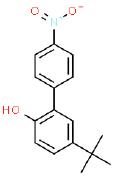 |
| 2. | n-Hexadecanoic acid | 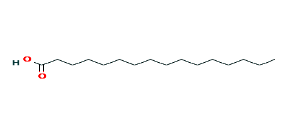 |
| 3. | 9,12-Octadecadienoic acid (Z,Z)- |  |
| 4. | 9-Octadecadienoic acid (E)- | 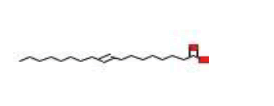 |
| 5. | Octadecadienoic acid |  |
| 6. | Hexadecanoic acid,2-hydroxy-1- | 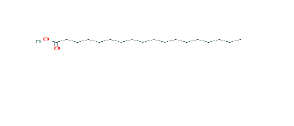 |
Table 4: Structures of the components identified in Fenugreek seed [GC MS study]
Conclusion
The results of these investigation revealed that the extraction of crude ethanol of fenugreek seed extract have been identified the twenty one unknown components in fenugreek seed by GC-MS analysis. In these GC-MS results at least six compounds of vigorous constituents accountable were present in the ethanol extract for many biological activities. So that those might be utilized for the growth of conventional medicines and further research may be to evaluate novel active compounds from the medicinal plants which may be produced a new way to treat many incurable diseases.
References
- Lal Karna SK, (2013) Phytochemical screening and gas chromatography–mass spectrometry and analysis of seed extract of trigonella foenum-graecum, linn (fenugreek /methi) Intern. Journ of Chemi Studies, 1: 209 -214.
[Crossref], [Google Scholar]
- Priya V, Jananie RK, Vijayalakshmi KJ (2011) GC/MS determination of bioactive components of trigonella foenum grecum. Chem Pharm Res 3:35-40.
[Crossref], [Google Scholar]
- Kumar GS (2005) Antidiabetic property of fenugreek seed mucilage and spent turmeric in streptozotocin-induced diabetic rats. Nutr Res 25: 1021–1028.
[Crossref], [Google Scholar]
- Dash BK (2011) Antibacterial and antifungal activities of several extracts of centella asiatica l. against some human pathogenic microbes. Life Sciences and Medicine Research 2011: 1-8.
[Crossref], [Google Scholar]
- Mahmood A (2013) Effect of hexanic and alcoholic extracts of fenugreek seed in male diabetic rats. Zahedan Journ of Res in Medical Scien 15: 50-53.
[Crossref], [Google Scholar]
- Antony Sandosh T, Paul John Peter M, Yesu Raj J (2013) Phytochemical analysis of stylosanthes fruticosa using UV-VIS, FTIR and GC-MS. Res J Chem Sci 3: 1-14.
[Crossref], [Google Scholar]
- El-Hawary SS, El-Tantawy ME, Rabeh MA,, Badr WK (2013) HPLC-PDA-MS/MS profiling of secondary metabolites from Opuntia ficus-indica cladode, peel and fruit pulp extracts and their antioxidant, neuroprotective effect in rats with aluminum chloride induced neurotoxicity. Intern Journ of Appl Res in Natural Product 6: 1-33.
[Crossref], [Google Scholar]
- Chenganmal M, Yamalai M (2015) AAS and GC-MS analysis of phytocomponents in the leaf, stem and root of Azadirachta indica A. Juss (Dongoyaro). Asian Journal of Plant Sciences 5: 61-65.
[Crossref], [Google Scholar]
- Dukes (2013) Phytochemical and Ethnobotanical Databases.
[Crossref], [Google Scholar]
- Duke (2013) Phytochemical and ethnobotanical databases, a cornerstone in the validation of ethnoveterinary medicinal plants, as demonstrated by data on pets in British Columbia. Medicinal and Aromatic Plants of North America 10: 219-246.
[Crossref], [Google Scholar]

Open Access Journals
- Aquaculture & Veterinary Science
- Chemistry & Chemical Sciences
- Clinical Sciences
- Engineering
- General Science
- Genetics & Molecular Biology
- Health Care & Nursing
- Immunology & Microbiology
- Materials Science
- Mathematics & Physics
- Medical Sciences
- Neurology & Psychiatry
- Oncology & Cancer Science
- Pharmaceutical Sciences
